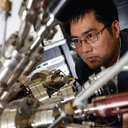Hesperidin pretreatment protects hypoxia-ischemic brain injury in neonatal rat.
Mots clés
Abstrait
Neonatal hypoxia-ischemic encephalopathy (HIE) remains a major cause of brain damage, leading to high disability and mortality rates in neonates. In vitro studies have shown that hesperidin, a flavanone glycoside found abundantly in citrus fruits, acts as an antioxidant. Although hesperidin has been considered as a potential treatment for HIE, its effects have not been fully evaluated. In this study, the protective effect of hesperidin pretreatment against hypoxia-ischemic (HI) brain injury and possible signal pathways were investigated using in vivo and in vitro models. In vivo HI model employed unilateral carotid ligation in postnatal day 7 rat with exposure to 8% hypoxia for 2.5h, whereas in vitro model employed primary cortical neurons of neonatal rats subjected to oxygen and glucose deprivation for 2.5h. Hesperidin pretreatment significantly reduced HI-induced brain tissue loss and improved neurological outcomes as shown in 2,3,5-triphenyltetrazolium chloride monohydrate staining and foot-fault results. The neuroprotective effects of hesperidin are likely the results of preventing an increase in intracellular reactive oxygen species and lipid peroxide levels. Hesperidin treatment also activated a key survival signaling kinase, Akt, and suppressed the P-FoxO3 level. Hesperidin pretreatment protected neonatal HIE by reducing free radicals and activating phosphorylated Akt.




